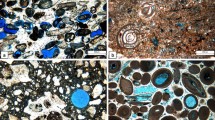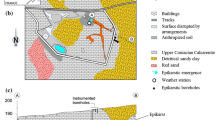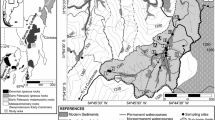Abstract
An experimental chamber (CIME2) has been specially designed to simulate wet atmospheric deposition on limestones used in Paris cultural heritage. This instrument is a complementary tool to CIME, a previously developed chamber dedicated to the simulation of dry atmospheric deposition on monuments and artifacts. The aim of this paper is to describe CIME2 and characterize the wet deposits produced inside it. Mist (fog), drizzle, and rainfall are differentiated in order to document their ability to saturate the limestones most currently used in Paris monuments: The Saint-Maximin’s limestone, the Liais of Saint-Maximin, and the Chauvigny’s limestone are tested. The comparison between normalized and environmental petrophysical data shows that in the wet deposition simulations, limestones are not systematically water-saturated. Moreover, the realistic experimental conditions chosen favor a more rapid evaporation of the stone water. The quantification of the non-saturation state is a first step that has to be taken into account to improve the geochemical models used to predict the alteration.











Similar content being viewed by others
References
AFNOR (1999) AFNOR B10-613, Méthodes d'essai pour pierres naturelles - Détermination du coefficient d'absorption d'eau par capillarité. Standard NF EN 1925. Association Française de Normalisation (AFNOR), Paris
AFNOR (2007) AFNOR B10-615, Méthodes d'essai des pierres naturelles - Détermination des masses volumiques réelle et apparente et des porosités ouverte et totale. Standard NF EN 1936. Association Française de Normalisation (AFNOR), Paris
ASTM D4404-10 (2010) Standard test method for determination of pore volume and pore volume distribution of soil and rock by mercury intrusion porosimetry. pp. 7
Ausset P, Crovisier JL, Del Monte M, Furlan V, Girardet F, Hammecker C, Jeannette D, Lefèvre R (1996) Experimental study of limestone and sandstone sulphation in polluted realistic conditions: the Lausanne atmospheric simulation chamber (LASC). Atmos Environ 30:3197–3207
Bernardi E, Chiavari C, Lenza B, Martini C, Morselli L, Ospitali F, Robbiola L (2009) The atmospheric corrosion of quaternary bronzes: the leaching action of acid rain. Corros Sci 51:159–170
Beysens D, Mongruel A, Acker K (2017) Urban dew and rain in Paris, France: occurrence and physico-chemical characteristics. Atmos Res 189:152–161
Bonazza A, Sabbioni C (2016) Composition and chemistry of crusts on stone. In: Brimblecombe P (ed) Air pollution reviews no. 5. Urban pollution and changes to materials and building surfaces. Imperial College Press, London, pp 103–123
Bonazza A, Messina P, Sabbioni C, Grossi CM, Brimblecombe P (2009) Mapping the impact of climate change on surface recession of carbonate buildings in Europe. Sci Total Environ 407(6):2039–2050
Buhmann D, Dreybrodt W (1985) The kinetics of calcite dissolution and precipitation in geologically relevant situations of karst areas. Chem Geol 48:189–211
Camuffo D (2016) Weathering of building materials. In: Brimblecombe P (ed) Air pollution reviews no. 5. Urban pollution and changes to materials and building surfaces. Imperial College Press, London, pp 19–64
Chabas A, Fouqueau A, Attoui M, Alfaro S, Petitmangin A, Bouilloux A, Saheb M, Coman A, Lombardo T, Grand N, Zapf P, Berardo R, Duranton M, Durand-Jolibois R, Jerome M, Pangui E, Correia JJ, Guillot I, Nowak S (2015) Characterization of CIME, an experimental chamber for simulating interactions between materials of the cultural heritage and the environment. Environ Sci Pollut Res 22:19170–19183
Chiavari C, Bernardi E, Martini C, Passarini F, Ospitali F, Robbiola L (2010) The atmospheric corrosion of quaternary bronzes: the action of stagnant rain water. Corros Sci 52:3002–3010
David C, Darot M, Jeannette D (1993) Pore structures and transport properties of sandstone. Transp Porous Media 11:161–177
Dewanckele J, De Kock T, Fronteau G, Derluyn H, Vontobel P, Dierick M, Van Hoorebeke L et al (2014) Neutron radiography and X-ray computed tomography for quantifying weathering and water uptake processes inside porous limestone used as building material. Mater Charact 88:86–99
Dunham RJ (1962) Classification of carbonate rocks according to depositional texture. In: Ham, W. E. (ed.) Classification of carbonate rocks. American Association of Petroleum Geologists, Memoirs, 1:108–121
Folk RL (1959) Practical petrographical classification of limestones. Am Assoc Pet Geol Bull 43:1–38
Franzoni E, Sassoni E (2011) Correlation between microstructural characteristics and weight loss of natural stones exposed to simulated acid rain. Sci Total Environ 412-413:278–285
Fripiat J, Chaussidon J, Jelli A (1971) Chimie physique des phénomènes de surfaces. Application aux oxydes et aux silicates. Edition Masson & Cie 387pp
Hammecker C, Jeannette D (1994) Modelling the capillary imbibition kinetics in sedimentary rocks: role of petrographical features. Transp Porous Media 17:285–303
Hammer E, Gysel M, Roberts GC, Elias T, Hofer J, Hoyle CR, Bukowiecki N, Dupont JC, Burnet F, Baltensperger U, Weingartner E (2014) Size-dependent particle activation properties in fog during the ParisFog 2012/13 field campaign. Atmos Chem Phys 14:10517–10533
Icomos (2008) Illustrated glossary on stone deterioration patterns ICOMOS International Scientific Committee for Stone (ISCS). 86 pages
Inkpen RJ, Viles HA, Moses C, Baily B, Collier P, Trudgill ST, Cooke RU (2012) Thirty years of erosion and declining atmospheric pollution at St Paul’s Cathedral, London. Atmos Environ 62:521–529
Le Moullec A, Mezdour A (2011) La qualité des eaux de pluie : acidité en baisse mais pas de progrès pour les dépôts d’azote. http://www.developpement-durable.gouv.fr/IMG/pdf/LPS88.pdf
Lefèvre RA, Ionescu A, Desplat J, Kounkou-Arnaud R, Perrussel O, Languille B (2016) Quantification and mapping of the impact of the recent air pollution abatement on limestone and window glass in Paris. Environ Earth Sci 75:1359
Livingston RA (1992) Graphical methods for examining the effects of acid rain and sulphur dioxide on carbonate stones. Proceedings of the 7th International Congress on Deterioration and Conservation of Stone, Lisbon, 375-386. In: J. Delgado Rodrigues, F. Henriques & F.Telmo Jeremias (eds)
Livingston RA (2016) Acid rain attack on outdoor sculpture in perspective. Atmos Environ 146:332–345
Merle D (2008) Stratotype Lutétien. Muséum National d’Histoire Naturelle, Paris; Edition Biotope, Mèze; BRGM, Orléans, 288p
Météofrance collectif (1971-2000) Statistiques climatiques de la France. 287p. http://www.meteofrance.fr/publications/nos-collections/climat/statistiques-climatiques-de-la-france-19712000
Pellerin FM, Zinszner B (2007) A geoscientist’s guide to petrophysics. IFP publication. Editions Technip
Plummer LN, Wigley TM (1976) The dissolution of calcite in CO2-saturated solutions at 25°C and 1 atmosphere total pressure. Geochim Cosmochim Acta 40:191–202
Podzimec J (1997) Droplet concentration and size distribution in haze and fog. Stud Geophys Geod 41(3):277–296
Rousset B (2001) Transferts par capillarité et évaporation dans des roches – rôle des structures de porosité. Thèse de l’Université Louis Pasteur – Strasbourg 1. 220 pp.
Rousset-Tournier B, Mazerolle F, Geraud Y, Jeannette D (2003) Rock drying test monitored by x-ray computed tomography—the effect of saturation methods on drying behavior. In: Mees F, Swenner R, Van Geet M, Jacobs (eds) Application of X-ray computed tomography in the geosciences, vol 215. Geological Society, London, Special Publication, pp 117–125
Sabbioni C (2003) Mechanisms of air pollution damage to stone. In: Brimblecombe P (ed) Air pollution reviews. The effects of air pollution on the built environment. Imperial College Press, London, pp 63–106
Saheb M, Chabas A, Mertz JD, Colas E, Rozenbaum O, Sizun JP, Nowak S, Gentaz L, Verney-Carron A (2016) Weathering of limestone after several decades in an urban environment. Corros Sci 111:742–752
Smith BJ, Viles HA (2006) Rapid, catastrophic decay of building limestones: thoughts on causes, effects and consequences. International Conference on Heritage, Weathering and Conservation Location, 1, 191–197. Edited by: Fort R, Alvarez De Buergo M, Gomez Heras M et al. Madrid. Spain
Steiger M (2016) Air pollution damage to stone. In: Brimblecombe P (ed) Air pollution reviews no. 5. Urban pollution and changes to materials and building surfaces. Imperial College Press, London, pp 65–101
Tétreault J, Dupont AL, Bégin P, Paris S (2013) The impact of volatile compounds released by paper on cellulose degradation in ambient hygrothermal conditions. Polym Degrad Stab 98:1827–1837
Turmel A, Fronteau G, Thomachot-Schneider C, Moreau C, Chalumeau L, Barbin V (2014) Stone uses in Reims Cathedral: provenance, physical properties and restoration phases. In: Cassar J, Winter MG, Marker BR, NRG W, Entwisle DC, Bromhead EN, JWN S (eds) Stone in historic buildings: characterization and performance, vol 391. Geological Society, London, Special Publication, pp 17–30
Unterwurzacher M, Mirwald P (2008) Initial stages of carbonate weathering: climate chamber studies under realistic pollution conditions. Environ Geol 56:507–519
Zinszner B, Meynot C (1982) Visualisation des propriétés capillaires des roches réservoirs. Rev Inst Fr Pétrole 37:337–361
Acknowledgments
This work was supported by the DIM R2DS French Regional Program (2013–2017) and the French National Research Agency (ANR JCJC GLAM Project (2014–2018). The authors thank J. Vatteville from LaVision for the PDI measurements.
Author information
Authors and Affiliations
Corresponding author
Additional information
Responsible editor: Michel Sablier
Highlights
• An experimental chamber designed for studying wet deposition on cultural heritage materials is described and characterized.
• Petrophysical measurements are performed in simulated Parisian environment.
• Rainfall, drizzle, and mist deposits are differentiated to evaluate their ability to saturate different porous networks.
Rights and permissions
About this article
Cite this article
Chabas, A., Sizun, JP., Gentaz, L. et al. Water content of limestones submitted to realistic wet deposition: a CIME2 chamber simulation. Environ Sci Pollut Res 25, 23973–23985 (2018). https://doi.org/10.1007/s11356-018-2433-0
Received:
Accepted:
Published:
Issue Date:
DOI: https://doi.org/10.1007/s11356-018-2433-0




